https://github.com/meshpro/pygalmesh
:spider_web: A Python interface to CGAL's meshing tools
https://github.com/meshpro/pygalmesh
cgal engineering mathematics mesh mesh-generation meshing python
Last synced: 5 days ago
JSON representation
:spider_web: A Python interface to CGAL's meshing tools
- Host: GitHub
- URL: https://github.com/meshpro/pygalmesh
- Owner: meshpro
- License: gpl-3.0
- Created: 2016-08-19T15:21:39.000Z (over 9 years ago)
- Default Branch: main
- Last Pushed: 2024-07-22T09:26:24.000Z (over 1 year ago)
- Last Synced: 2025-03-09T11:36:15.962Z (9 months ago)
- Topics: cgal, engineering, mathematics, mesh, mesh-generation, meshing, python
- Language: C++
- Homepage:
- Size: 4.19 MB
- Stars: 618
- Watchers: 21
- Forks: 60
- Open Issues: 31
-
Metadata Files:
- Readme: README.md
- License: LICENSE
- Citation: CITATION.cff
Awesome Lists containing this project
- awesome-scientific-computing - pygalmesh - Python interface for CGAL's 3D meshing capabilities. (Meshing / Triangular and tetrahedral meshing)
- awesome-eit - pygalmesh
README
Create high-quality meshes with ease.
[](https://pypi.org/project/pygalmesh)
[](https://anaconda.org/conda-forge/pygalmesh/)
[](https://repology.org/project/pygalmesh/versions)
[](https://pypi.org/pypi/pygalmesh/)
[](https://doi.org/10.5281/zenodo.5564818)
[](https://github.com/nschloe/pygalmesh)
[](https://pepy.tech/project/pygalmesh)
[](https://discord.gg/Z6DMsJh4Hr)
[](https://github.com/nschloe/pygalmesh/actions?query=workflow%3Aci)
[](https://codecov.io/gh/nschloe/pygalmesh)
[](https://lgtm.com/projects/g/nschloe/pygalmesh)
[](https://github.com/psf/black)
pygalmesh is a Python frontend to [CGAL](https://www.cgal.org/)'s
[2D](https://doc.cgal.org/latest/Mesh_2/index.html) and [3D mesh generation
capabilities](https://doc.cgal.org/latest/Mesh_3/index.html). pygalmesh makes it easy
to create high-quality 2D, 3D volume meshes, periodic volume meshes, and surface meshes.
### Examples
#### 2D meshes

CGAL generates 2D meshes from linear constraints.
```python
import numpy as np
import pygalmesh
points = np.array([[0.0, 0.0], [1.0, 0.0], [1.0, 1.0], [0.0, 1.0]])
constraints = [[0, 1], [1, 2], [2, 3], [3, 0]]
mesh = pygalmesh.generate_2d(
points,
constraints,
max_edge_size=1.0e-1,
num_lloyd_steps=10,
)
# mesh.points, mesh.cells
```
The quality of the mesh isn't very good, but can be improved with
[optimesh](https://github.com/nschloe/optimesh).
#### A simple ball

```python
import pygalmesh
s = pygalmesh.Ball([0, 0, 0], 1.0)
mesh = pygalmesh.generate_mesh(s, max_cell_circumradius=0.2)
# mesh.points, mesh.cells, ...
```
You can write the mesh with
```python
mesh.write("out.vtk")
```
You can use any format supported by [meshio](https://github.com/nschloe/meshio).
The mesh generation comes with many more options, described
[here](https://doc.cgal.org/latest/Mesh_3/). Try, for example,
```python
mesh = pygalmesh.generate_mesh(
s, max_cell_circumradius=0.2, odt=True, lloyd=True, verbose=False
)
```
#### Other primitive shapes
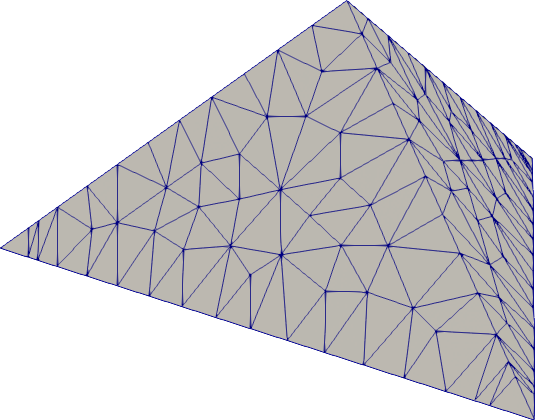
pygalmesh provides out-of-the-box support for balls, cuboids, ellipsoids, tori, cones,
cylinders, and tetrahedra. Try for example
```python
import pygalmesh
s0 = pygalmesh.Tetrahedron(
[0.0, 0.0, 0.0], [1.0, 0.0, 0.0], [0.0, 1.0, 0.0], [0.0, 0.0, 1.0]
)
mesh = pygalmesh.generate_mesh(
s0,
max_cell_circumradius=0.1,
max_edge_size_at_feature_edges=0.1,
)
```
#### Domain combinations
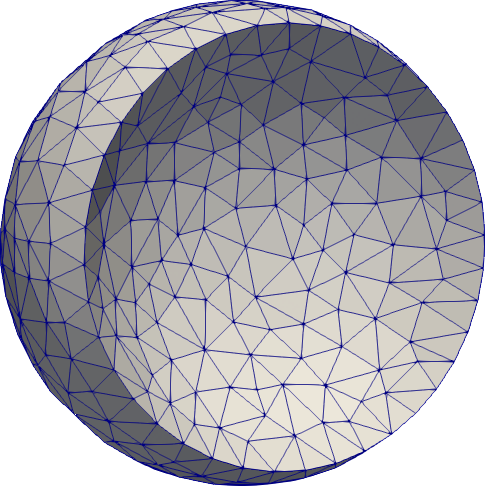
Supported are unions, intersections, and differences of all domains. As mentioned above,
however, the sharp intersections between two domains are not automatically handled. Try
for example
```python
import pygalmesh
radius = 1.0
displacement = 0.5
s0 = pygalmesh.Ball([displacement, 0, 0], radius)
s1 = pygalmesh.Ball([-displacement, 0, 0], radius)
u = pygalmesh.Difference(s0, s1)
```
To sharpen the intersection circle, add it as a feature edge polygon line, e.g.,
```python
import numpy as np
import pygalmesh
radius = 1.0
displacement = 0.5
s0 = pygalmesh.Ball([displacement, 0, 0], radius)
s1 = pygalmesh.Ball([-displacement, 0, 0], radius)
u = pygalmesh.Difference(s0, s1)
# add circle
a = np.sqrt(radius**2 - displacement**2)
max_edge_size_at_feature_edges = 0.15
n = int(2 * np.pi * a / max_edge_size_at_feature_edges)
alpha = np.linspace(0.0, 2 * np.pi, n + 1)
alpha[-1] = alpha[0]
circ = a * np.column_stack([np.zeros(n + 1), np.cos(alpha), np.sin(alpha)])
mesh = pygalmesh.generate_mesh(
u,
extra_feature_edges=[circ],
max_cell_circumradius=0.15,
max_edge_size_at_feature_edges=max_edge_size_at_feature_edges,
min_facet_angle=25,
max_radius_surface_delaunay_ball=0.15,
max_circumradius_edge_ratio=2.0,
)
```
Note that the length of the polygon legs are kept in sync with
`max_edge_size_at_feature_edges` of the mesh generation. This makes sure that it fits in
nicely with the rest of the mesh.
#### Domain deformations

You can of course translate, rotate, scale, and stretch any domain. Try, for example,
```python
import pygalmesh
s = pygalmesh.Stretch(pygalmesh.Ball([0, 0, 0], 1.0), [1.0, 2.0, 0.0])
mesh = pygalmesh.generate_mesh(s, max_cell_circumradius=0.1)
```
#### Extrusion of 2D polygons
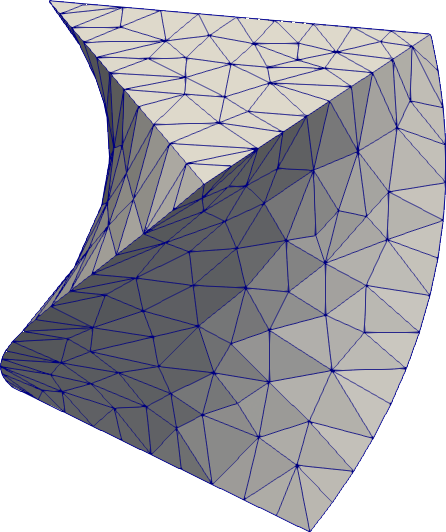
pygalmesh lets you extrude any polygon into a 3D body. It even supports rotation
alongside!
```python
import pygalmesh
p = pygalmesh.Polygon2D([[-0.5, -0.3], [0.5, -0.3], [0.0, 0.5]])
max_edge_size_at_feature_edges = 0.1
domain = pygalmesh.Extrude(
p,
[0.0, 0.0, 1.0],
0.5 * 3.14159265359,
max_edge_size_at_feature_edges,
)
mesh = pygalmesh.generate_mesh(
domain,
max_cell_circumradius=0.1,
max_edge_size_at_feature_edges=max_edge_size_at_feature_edges,
verbose=False,
)
```
Feature edges are automatically preserved here, which is why an edge length needs to be
given to `pygalmesh.Extrude`.
#### Rotation bodies
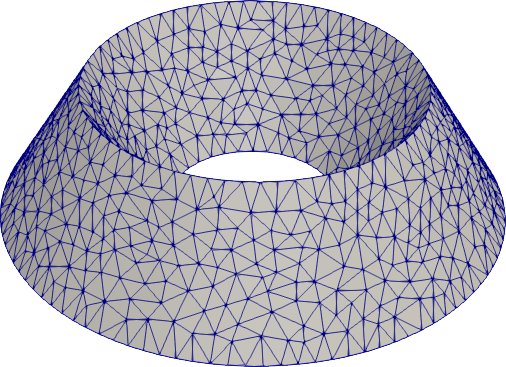
Polygons in the x-z-plane can also be rotated around the z-axis to yield a rotation
body.
```python
import pygalmesh
p = pygalmesh.Polygon2D([[0.5, -0.3], [1.5, -0.3], [1.0, 0.5]])
max_edge_size_at_feature_edges = 0.1
domain = pygalmesh.RingExtrude(p, max_edge_size_at_feature_edges)
mesh = pygalmesh.generate_mesh(
domain,
max_cell_circumradius=0.1,
max_edge_size_at_feature_edges=max_edge_size_at_feature_edges,
verbose=False,
)
```
#### Your own custom level set function

If all of the variety is not enough for you, you can define your own custom level set
function. You simply need to subclass `pygalmesh.DomainBase` and specify a function,
e.g.,
```python
import pygalmesh
class Heart(pygalmesh.DomainBase):
def __init__(self):
super().__init__()
def eval(self, x):
return (
(x[0] ** 2 + 9.0 / 4.0 * x[1] ** 2 + x[2] ** 2 - 1) ** 3
- x[0] ** 2 * x[2] ** 3
- 9.0 / 80.0 * x[1] ** 2 * x[2] ** 3
)
def get_bounding_sphere_squared_radius(self):
return 10.0
d = Heart()
mesh = pygalmesh.generate_mesh(d, max_cell_circumradius=0.1)
```
Note that you need to specify the square of a bounding sphere radius, used as an input
to CGAL's mesh generator.
#### Local refinement
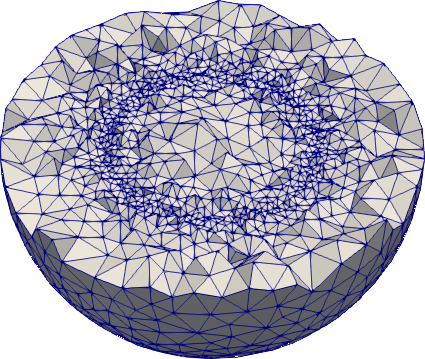
Use `generate_mesh` with a function (regular or lambda) as `max_cell_circumradius`. The
same goes for `max_edge_size_at_feature_edges`, `max_radius_surface_delaunay_ball`, and
`max_facet_distance`.
```python
import numpy as np
import pygalmesh
mesh = pygalmesh.generate_mesh(
pygalmesh.Ball([0.0, 0.0, 0.0], 1.0),
min_facet_angle=30.0,
max_radius_surface_delaunay_ball=0.1,
max_facet_distance=0.025,
max_circumradius_edge_ratio=2.0,
max_cell_circumradius=lambda x: abs(np.sqrt(np.dot(x, x)) - 0.5) / 5 + 0.025,
)
```
#### Surface meshes
If you're only after the surface of a body, pygalmesh has `generate_surface_mesh` for
you. It offers fewer options (obviously, `max_cell_circumradius` is gone), but otherwise
works the same way:
```python
import pygalmesh
s = pygalmesh.Ball([0, 0, 0], 1.0)
mesh = pygalmesh.generate_surface_mesh(
s,
min_facet_angle=30.0,
max_radius_surface_delaunay_ball=0.1,
max_facet_distance=0.1,
)
```
Refer to [CGAL's
documentation](https://doc.cgal.org/latest/Surface_mesher/index.html) for the
options.
#### Periodic volume meshes

pygalmesh also interfaces CGAL's [3D periodic
mesh generation](https://doc.cgal.org/latest/Periodic_3_mesh_3/index.html). Besides a
domain, one needs to specify a bounding box, and optionally the number of copies in the
output (1, 2, 4, or 8). Example:
```python
import numpy as np
import pygalmesh
class Schwarz(pygalmesh.DomainBase):
def __init__(self):
super().__init__()
def eval(self, x):
x2 = np.cos(x[0] * 2 * np.pi)
y2 = np.cos(x[1] * 2 * np.pi)
z2 = np.cos(x[2] * 2 * np.pi)
return x2 + y2 + z2
mesh = pygalmesh.generate_periodic_mesh(
Schwarz(),
[0, 0, 0, 1, 1, 1],
max_cell_circumradius=0.05,
min_facet_angle=30,
max_radius_surface_delaunay_ball=0.05,
max_facet_distance=0.025,
max_circumradius_edge_ratio=2.0,
number_of_copies_in_output=4,
# odt=True,
# lloyd=True,
verbose=False,
)
```
#### Volume meshes from surface meshes

If you have a surface mesh at hand (like
[elephant.vtu](http://meshpro.github.io/pygalmesh/elephant.vtu)), pygalmesh generates a
volume mesh on the command line via
```
pygalmesh volume-from-surface elephant.vtu out.vtk --cell-size 1.0 --odt
```
(See `pygalmesh volume-from-surface -h` for all options.)
In Python, do
```python
import pygalmesh
mesh = pygalmesh.generate_volume_mesh_from_surface_mesh(
"elephant.vtu",
min_facet_angle=25.0,
max_radius_surface_delaunay_ball=0.15,
max_facet_distance=0.008,
max_circumradius_edge_ratio=3.0,
verbose=False,
)
```
#### Meshes from INR voxel files

It is also possible to generate meshes from INR voxel files, e.g.,
[here](https://github.com/CGAL/cgal/tree/master/Mesh_3/examples/Mesh_3/data) either on
the command line
```
pygalmesh from-inr skull_2.9.inr out.vtu --cell-size 5.0 --odt
```
(see `pygalmesh from-inr -h` for all options) or from Python
```python
import pygalmesh
mesh = pygalmesh.generate_from_inr(
"skull_2.9.inr",
max_cell_circumradius=5.0,
verbose=False,
)
```
#### Meshes from numpy arrays representing 3D images
| 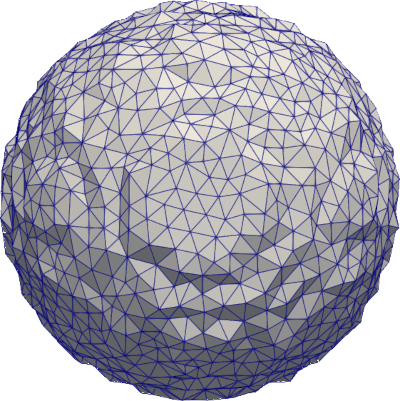 |
|  |
|
| :------------------------------------------------------------------------: | :---------------------------------------------------------------------: |
pygalmesh can help generating unstructed meshes from 3D numpy int arrays specifying the
subdomains. Subdomains with key `0` are not meshed.
```python
import pygalmesh
import numpy as np
x_ = np.linspace(-1.0, 1.0, 50)
y_ = np.linspace(-1.0, 1.0, 50)
z_ = np.linspace(-1.0, 1.0, 50)
x, y, z = np.meshgrid(x_, y_, z_)
vol = np.empty((50, 50, 50), dtype=np.uint8)
idx = x**2 + y**2 + z**2 < 0.5**2
vol[idx] = 1
vol[~idx] = 0
voxel_size = (0.1, 0.1, 0.1)
mesh = pygalmesh.generate_from_array(
vol, voxel_size, max_facet_distance=0.2, max_cell_circumradius=0.1
)
mesh.write("ball.vtk")
```
The code below creates a mesh from the 3D breast phantom from [Lou et
al](http://biomedicaloptics.spiedigitallibrary.org/article.aspx?articleid=2600985)
available
[here](https://wustl.app.box.com/s/rqivtin0xcofjwlkz43acou8jknsbfx8/file/127108205145).
The phantom comprises four tissue types (background, fat, fibrograndular, skin, vascular
tissues). The generated mesh conforms to tissues interfaces.
```python
import pygalmesh
import meshio
with open("MergedPhantom.DAT", "rb") as fid:
vol = np.fromfile(fid, dtype=np.uint8)
vol = vol.reshape((722, 411, 284))
voxel_size = (0.2, 0.2, 0.2)
mesh = pygalmesh.generate_from_array(
vol, voxel_size, max_facet_distance=0.2, max_cell_circumradius=1.0
)
mesh.write("breast.vtk")
```
In addition, we can specify different mesh sizes for each tissue type. The code below
sets the mesh size to _1 mm_ for the skin tissue (label `4`), _0.5 mm_ for the vascular
tissue (label `5`), and _2 mm_ for all other tissues (`default`).
```python
mesh = pygalmesh.generate_from_array(
vol,
voxel_size,
max_facet_distance=0.2,
max_cell_circumradius={"default": 2.0, 4: 1.0, 5: 0.5},
)
mesh.write("breast_adapted.vtk")
```
#### Surface remeshing
| 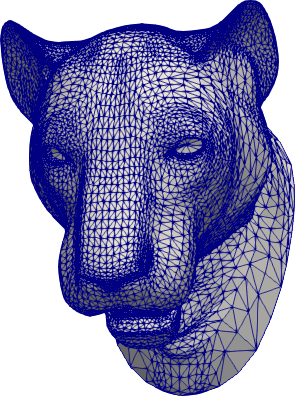 |
| 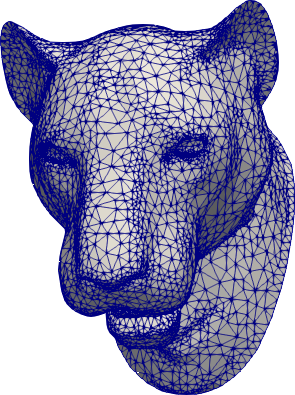 |
|
| :-------------------------------------------------------------------------: | :-------------------------------------------------------------------------: |
pygalmesh can help remeshing an existing surface mesh, e.g.,
[`lion-head.off`](https://github.com/nschloe/pygalmesh/raw/gh-pages/lion-head.off). On
the command line, use
```
pygalmesh remesh-surface lion-head.off out.vtu -e 0.025 -a 25 -s 0.1 -d 0.001
```
(see `pygalmesh remesh-surface -h` for all options) or from Python
```python
import pygalmesh
mesh = pygalmesh.remesh_surface(
"lion-head.off",
max_edge_size_at_feature_edges=0.025,
min_facet_angle=25,
max_radius_surface_delaunay_ball=0.1,
max_facet_distance=0.001,
verbose=False,
)
```
### Installation
For installation, pygalmesh needs [CGAL](https://www.cgal.org/) and
[Eigen](http://eigen.tuxfamily.org/index.php?title=Main_Page) installed on your
system. They are typically available on your Linux distribution, e.g., on
Ubuntu
```
sudo apt install libcgal-dev libeigen3-dev
```
On MacOS with homebrew,
```
brew install cgal eigen
```
After that, pygalmesh can be [installed from the Python Package
Index](https://pypi.org/project/pygalmesh/), so with
```
pip install -U pygalmesh
```
you can install/upgrade.
#### Troubleshooting
If pygalmesh fails to build due to `fatal error: 'Eigen/Dense' file not found`
you will need to create a symbolic link for Eigen to be detected, e.g.
```
cd /usr/local/include
sudo ln -sf eigen3/Eigen Eigen
```
It's possible that `eigen3` could be in `/usr/include` instead of
`/usr/local/install`.
#### Manual installation
For manual installation (if you're a developer or just really keen on getting
the bleeding edge version of pygalmesh), there are two possibilities:
- Get the sources, type `python3 setup.py install`. This does the trick
most the time.
- As a fallback, there's a CMake-based installation. Simply go `cmake /path/to/sources/` and `make`.
### Testing
To run the pygalmesh unit tests, check out this repository and type
```
pytest
```
### Background
CGAL offers two different approaches for mesh generation:
1. Meshes defined implicitly by level sets of functions.
2. Meshes defined by a set of bounding planes.
pygalmesh provides a front-end to the first approach, which has the following advantages
and disadvantages:
- All boundary points are guaranteed to be in the level set within any specified
residual. This results in smooth curved surfaces.
- Sharp intersections of subdomains (e.g., in unions or differences of sets) need to be
specified manually (via feature edges, see below), which can be tedious.
On the other hand, the bounding-plane approach (realized by
[mshr](https://bitbucket.org/fenics-project/mshr)), has the following properties:
- Smooth, curved domains are approximated by a set of bounding planes, resulting in more
of less visible edges.
- Intersections of domains can be computed automatically, so domain unions etc. have
sharp edges where they belong.
See [here](https://github.com/nschloe/awesome-scientific-computing#meshing) for other
mesh generation tools.
### License
This software is available under the [GPLv3
license](https://www.gnu.org/licenses/gpl-3.0.en.html) as well as a commercial
license. If you'd like to use this software commercially, please contact the
author.